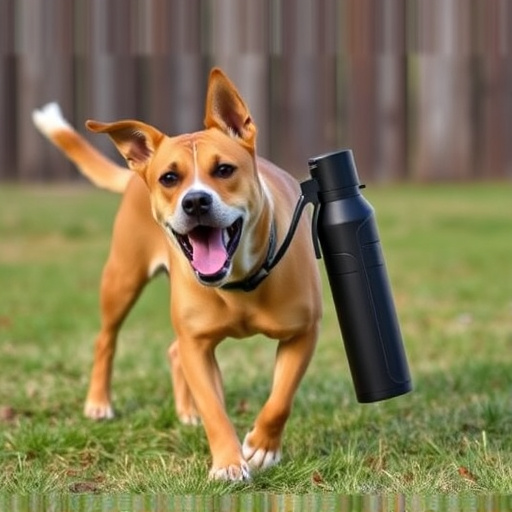Mace animal pepper sprays contain capsaicin, irritating dogs and wild creatures. After exposure, swiftly decontaminate pets with warm water, mild shampoo, and gentle rinsing. Don't scratch or lick affected areas as residue can cause continued irritation. Seek veterinary care for severe symptoms like breathing difficulties. Prompt decontamination minimizes harm and facilitates quick recovery.
“Mace formula animal pepper spray, a powerful tool for self-defense, has sparked curiosity and raised concerns among pet owners. This article unravels the complexities of mace spray on animals, offering insights into its ingredients, effects, and decontamination processes. We demystify common misconceptions and provide practical steps to protect and decontaminate your pets after exposure. Learn about effective prevention strategies to safeguard your furry companions from irritants, ensuring their well-being in various situations.”
- Understanding Mace Formula Animal Pepper Spray: Ingredients and Effects
- Steps to Decontaminate Your Pet After Exposure to Mace Spray
- Common Misconceptions About Pepper Spray and Pets: Debunking myths
- Prevention Strategies: Protecting Your Pets from Mace and Other Irritants
Understanding Mace Formula Animal Pepper Spray: Ingredients and Effects
Mace formula animal pepper spray is a specialized product designed to protect against aggressive animals, particularly dogs and other wild or feral creatures. Understanding its ingredients and effects is crucial when considering its use for self-defense or for decontaminating pets after exposure. The active ingredient in most mace sprays is capsaicin, derived from chili peppers. This compound irritates the eyes, nose, and respiratory system of animals, causing them to temporarily retreat or become deterred.
In addition to capsaicin, these sprays may contain other ingredients like water, glycerin, and various preservatives. These components help in delivering the capsaicin effectively while ensuring the spray is safe for human use (when not aimed at the eyes). After a pet is exposed to mace spray, decontaminating them promptly is essential. This involves rinsing their fur with warm water and gentle shampoo to remove any remaining spray residue, focusing particularly on the face and paws where irritation can be most severe.
Steps to Decontaminate Your Pet After Exposure to Mace Spray
After your pet has been exposed to mace spray, decontaminating them promptly is crucial. Start by removing any contaminated clothing or accessories and rinse their fur thoroughly with warm water. Use a mild, tear-free shampoo to clean their coat, making sure to lather well and rinse until all residue is gone.
For eyes and skin irritation, gently wash the affected areas with plain water for at least 15 minutes. Soothe any discomfort with a cold compress and consult a veterinarian if irritation persists. Finally, wipe down your pet’s paws and face with a damp cloth to remove any remaining spray particles, ensuring a complete decontaminations process.
Common Misconceptions About Pepper Spray and Pets: Debunking myths
Many pet owners hold misconceptions about pepper spray and its effects on animals, often leading to ineffective decontamination strategies after exposure. One common myth is that pepper spray is harmless to pets, which couldn’t be further from the truth. It’s crucial to understand that pepper spray, or capsaicin, can cause severe irritation and pain in both humans and animals, with symptoms including coughing, difficulty breathing, and even blindness if it comes into contact with eyes.
Another misconception is that once the effects of pepper spray subside, pets will be fine without any further decontamination. However, the chemical can leave a residue on fur and skin, which, when scratched or licked, can cause continued irritation and potential toxicity. To properly decontaminate a pet after Mace exposure, gently wash the affected area with warm water and mild soap. Rinse thoroughly to remove any remaining pepper spray residue. If symptoms persist or severe reactions occur, seeking veterinary care is essential.
Prevention Strategies: Protecting Your Pets from Mace and Other Irritants
If your pet comes into contact with mace or any other irritant, quick action is crucial to prevent serious health issues. The first step in protecting your pets from such substances is understanding their potential effects. Mace can cause temporary blindness, difficulty breathing, and severe pain, so it’s essential to act fast if your pet is exposed. Start by moving your pet to a safe, well-ventilated area away from the source of the irritant.
To decontaminate your pet after mace exposure, rinse the affected areas gently with warm water. If possible, remove any clothing or gear that might have come into direct contact with the substance. Contact your veterinarian immediately for further guidance, as they can provide specific advice based on your pet’s condition and the type of irritant involved. Remember, prompt decontamination is key to minimising potential harm and ensuring your beloved companion recovers quickly.
Mace formula animal pepper spray, while a powerful tool for personal safety, requires careful consideration when it comes to our pets. By understanding its ingredients, effects, and proper decontamination methods, such as thoroughly rinsing affected areas with water, we can ensure our furry friends’ well-being after exposure. Debunking common misconceptions and implementing prevention strategies, like keeping pepper spray out of reach, will help protect our pets from the irritant compounds present in mace spray, ultimately fostering a safer environment for them.
